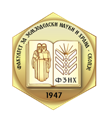THE QUALITY OF MATURE ROMANIJA’S KAJMAK
Keywords:
kajmak, physico-chemical composition, sensory characteristics.Abstract
Romanija’s kajmak is an autochthonous dairy product, characterized by an extremely high content of milk fat, specific technology and unique sensory characteristics. It can be consumed as fresh (ripened up to 20 days) or mature (ripened for 2 months). Considering that today Romanija’s kajmak is mostly consumed as matured, the aim of this research was to determine its physico-chemical composition and sensory properties at different time of ripening (30, 40 and 60 days). Total of 20 samples were collected from the region of Romanija mountain (B&H). However, since two samples did not meet requirements for hygienic quality, they were excluded from the study. According to defined quality parameters (minimum 70% of fat in dry matter and more than 65% dry matter) all investigated samples were categorized as mature kajmak. Time of ripening did not significantly affect dry matter and fat content (p˃0.05). As expected, the highest ripening index (32.14%) was found in 60 days ripened samples of Romanija’s kajmak. Due to proteolysis, in these samples the lowest protein content was observed – 5.31% (p˂0.05). Also, degradation of proteins after 40 and 60 days of ripening led to higher pH values compared to kajmak ripened for 30 days, probably as a result of the formation of alkaline compounds. According to sensory evaluation, time of ripening had influenced appearance and structure of kajmak, but no differences were found in other sensory parameters. Overall quality of kajmak was not affected by the time of ripening and was in range 15.25-15.93.



